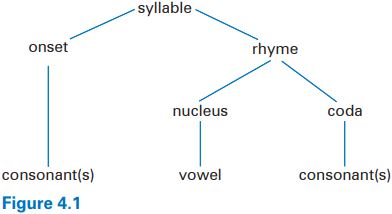


 Grammar
Grammar
 Tenses
Tenses
 Present
Present
 Past
Past
 Future
Future
 Parts Of Speech
Parts Of Speech
 Nouns
Nouns
 Verbs
Verbs
 Adverbs
Adverbs
 Adjectives
Adjectives
 Pronouns
Pronouns
 Pre Position
Pre Position
 Preposition by function
Preposition by function 
 Preposition by construction
Preposition by construction
 Conjunctions
Conjunctions
 Interjections
Interjections
 Grammar Rules
Grammar Rules
 Linguistics
Linguistics
 Semantics
Semantics
 Pragmatics
Pragmatics
 Reading Comprehension
Reading Comprehension|
Read More
Date: 2024-06-14
Date: 2024-04-27
Date: 2024-02-29
|
Syllables
A syllable must contain a vowel or vowel-like sound, including diphthongs. The most common type of syllable in language also has a consonant (C) before the vowel (V) and is typically represented as CV. Technically, the basic elements of the syllable are the onset (one or more consonants) followed by the rhyme. The rhyme (sometimes written as “rime”) consists of a vowel, which is treated as the nucleus, plus any following consonant(s), described as the coda.

Syllables like me, to or no have an onset and a nucleus, but no coda. They are known as open syllables. When a coda is present, as in the syllables up, cup, at or hat, they are called closed syllables. The basic structure of the kind of syllable found in English words like green (CCVC), eggs (VCC), and (VCC), ham (CVC), I (V), do (CV), not (CVC), like (CVC), them (CVC), Sam (CVC), I (V), am (VC) .
|
|
|
|
دراسة يابانية لتقليل مخاطر أمراض المواليد منخفضي الوزن
|
|
|
|
|
|
|
اكتشاف أكبر مرجان في العالم قبالة سواحل جزر سليمان
|
|
|
|
|
|
|
اتحاد كليات الطب الملكية البريطانية يشيد بالمستوى العلمي لطلبة جامعة العميد وبيئتها التعليمية
|
|
|